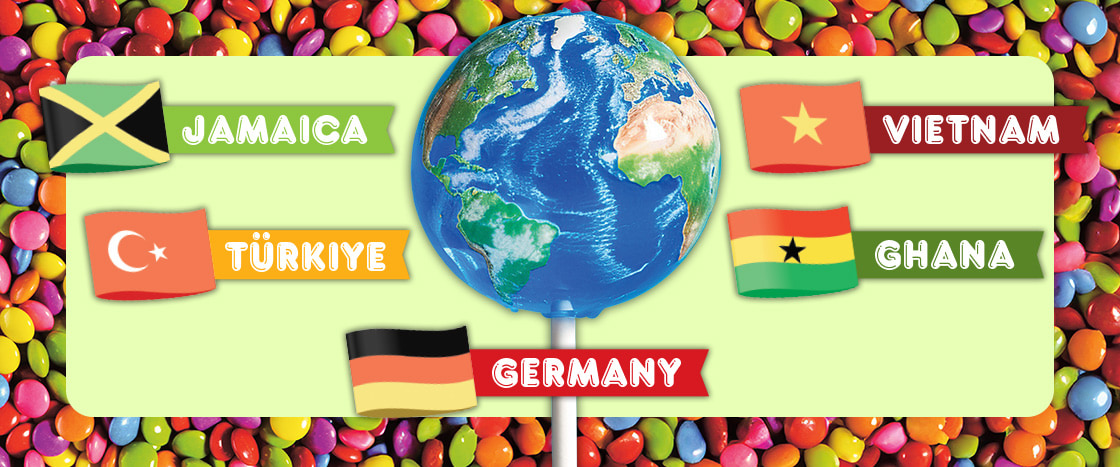Coconut drops are made by cooking fresh coconut and ginger in a hot brown sugar syrup. After the mix is scooped out of the pot, it cools into chewy candy. Yum!

Candy Around the World
Whether chewy, crunchy, sugary, or spicy, these treats from around the globe are all pretty sweet. Which one would you try?

Jamaica
Türkiye (Pronounced toor-kee-YEH)
These jelly snacks, called Turkish delight, were first made in the late 1700s. Today’s popular flavors include rose water, pistachio, lemon, and mint—with or without nuts.
Germany
Gummy bears were invented by German company Haribo in 1922. Today the company makes 100 million of them each year. (That’s enough to circle the globe four times!)
Ghana
This lemon-flavored milk chocolate bar is called akuafo (ah-KWAH-foh), which means farmer in a local language. It was made to honor farmers of cacao beans used to make chocolate. Africa produces 70 percent of the world’s cacao beans!
Vietnam
Tamarind candies are sweet, sour, and spicy all at once. The fruit they’re made of—tamarind—is packed with nutrients and gives many dishes in Southeast Asia a tangy punch!
Write to Win
Create a flyer advertising a new international candy store and encouraging people to come. Explain what types of candies will be sold and why, using details from the infographic. Entries must be submitted to “Candy Contest” by a teacher, parent, or legal guardian.* Three winners will each receive a $25 gift card for the Scholastic Store Online.
Contest deadline: March 1, 2025 (Note: This deadline has been extended.)
*Entries must be written by a student in grades 2-8 and submitted by their teacher, parent, or legal guardian, who will be the entrant and must be a legal resident of the U.S. age 18 or older. Visit the Storyworks Contests page for more information.
This infographic was originally published in the December 2024/January 2025 issue.
1. Preparing to Read
- Have students preview the infographic, including the headline, subhead, images, and the “Write to Win” box.
- Ask: Is the purpose of the infographic to:
- explain something to you?
- convince you of something?
- tell you how to do something?
- If a video is included with the infographic, show it to the class.
2. Reading and Discussing the Infographic
- Break students into groups to read each section of the infographic and discuss what they find interesting, surprising, convincing, or confusing.
- Come back together as a class and ask volunteers to summarize the main idea and supporting details from the infographic.
3. Skill Building and Writing
- Distribute the Guided Writing skill builder, which will help students identify key details in the infographic and respond to the writing prompt in the “Write to Win” box. If you’d like, you, a parent, or legal guardian can submit students’ entries to the writing contest. Find more details at storyworks.scholastic.com/pages/storyworks-contests.
- Optional: Distribute the Make Your Own Infographic activity, which guides students to choose a topic, research it, and create an infographic to share information.
